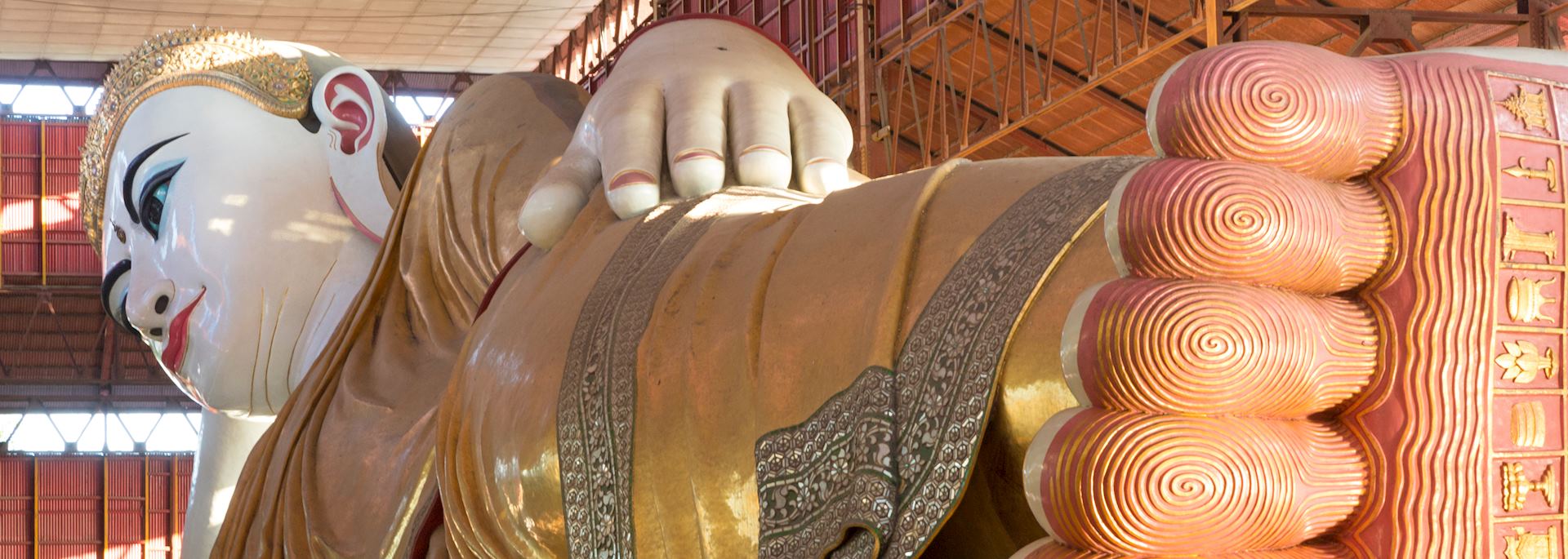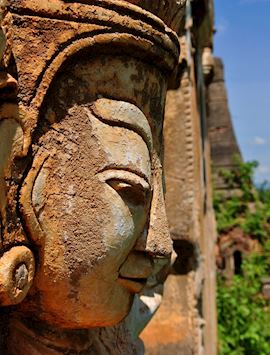By Myanmar specialist Hannah
Wherever you travel in Myanmar, you're only footsteps away from a temple. The Burmese people live through their Buddhist faith and have built the means to worship whatever their surroundings.
Some 4,000 temples rise from the plain at Bagan. They're the country's equivalent to Angkor Wat, and if you travel to Myanmar for the first time it's almost inconceivable that you won't visit here.
But, leaving Bagan aside, I've chosen three of Myanmar's other focal temple sites which spoke to me in different ways when I explored them, and demonstrate just how versatile and high-reaching the Burmese were as temple builders.
Shwedagon Pagoda in Yangon

The monumental golden tower of the Shwedagon Pagoda stands proud at almost 100 metres tall, reaching high above Yangon's sprawling skyline. No matter where you are in the city, you'll be able to pick out this pagoda among the old mansions and tea houses. It's one of the largest and most sacred religious sites in Myanmar.
When visiting Shwedagon, don't be afraid to ask your guide for 10 minutes or so to explore by yourself. It's an intricate complex made up of the imposing central stupa surrounded by smaller pagodas, praying houses and shrines. And, while guides are an invaluable source of knowledge, it's particularly rewarding to stumble upon some of the temple's hidden nooks and crannies alone.
Shwedagon is the country's most popular temple for a reason: Buddhists believe that eight hairs of the Lord Buddha are enshrined here. The temple attracts swathes of pilgrims, and I found it fascinating to watch them show their devotion.
Even if you aren't religious, it's an intimate sight to behold. Buddhists want to connect with their religion for all manner of reasons, whether asking for forgiveness, praying for luck in their granddaughter's upcoming marriage, or to dispel misfortune.
Statues of eight different animals stand in the temple — one for each day of the Burmese week, with Wednesday split into two. Worshippers pour water over the animal that represents their day of birth as part of their religious practice, in my case a rat, symbolising Thursday's child.
Best time of day to visit the Shwedagon Pagoda

You'll need a good couple of hours at Shwedagon Pagoda and I'd recommend visiting just before sunset as the sky changes from blue to red to purple, finally descending into darkness with the golden towers glistening in the moonlight. This is also a quieter, cooler and more comfortable time of day to explore the complex.
For keen photographers, the softening light also provides a number of fantastic opportunities. Due to the sheer size of Shwedagon鈥檚 main stupa, it鈥檚 very difficult to capture the whole building on camera. But the evening light reflects beautifully around the central shrine, which you can capture in detail.
On my last trip, my guide ushered me to an ornate tiled area from where I could gaze up at the jewelled top of the main stupa, which is studded with diamonds and rubies. The centrepiece of this display is a 76-carat diamond and if you move around the tiles in the evening light you'll watch it glowing different colours — scarlet, sapphire and emerald.
How to get to the Shwedagon Pagoda
A former colonial city, Yangon is situated in the south of Myanmar and is the gateway to the country.
The Shwedagon Pagoda is just a short taxi ride from central Yangon. However, the temple is often included in city tours and a local guide will show you the way. If you're visiting alone, it's worth noting the temple has four entrances, and you can enter by any of them.

When to visit the Shwedagon Pagoda
The best time of the year to visit Shwedagon Pagoda very much depends on how you would like to experience it. To miss the crowds, travel to Myanmar between October and November. At this time the country will just be coming out of green season and the golden spires of the temple shimmer against a lush, leafy backdrop.
Between January and February, the Shwedagon Festival takes place. Hordes of devotees descend on the temple en masse, coming together to dance, sing and celebrate their faith in unity. I found this a busy but exhilarating time to visit.
Where to eat near the Shwedagon Pagoda
Dining options vary in Yangon, and the city is starting to gain a touch of the cosmopolitan. Le Planteur, a fine dining restaurant offering French dishes, is just seven minutes away from Shwedagon by taxi.
Alternatively, head downtown to the Japanese restaurant, Geko. It's new, young and hip, and live music accompanies the yakitori.
Bronze Buddha statue at the Mahu Muni Pagoda, Mandalay

Considered the second most important temple in Myanmar, some Buddhists believe the Lord Buddha himself resides in the bronze cast Buddha statue here.
This four-metre-tall image is believed to have been made in the Rakhine State, where legend has it that the king was so impressed with the Buddha's teachings he forged the statue out of bronze. The statue has survived warfare and fire, and is an integral part of any visit to the pagoda.
I also toured the workshops on the steps leading to the temple. Here, local craftspeople demonstrate their skills in stone and marble carving, gold-leaf beating and puppet making. A local lady showed me how gold leaf is made, with my guide acting as translator, and afterwards we shared breakfast.
How to get to the Mahu Muni Pagoda
Mandalay is home to the Mahu Muni Pagoda. It's known as Myanmar's cultural capital and lies in the very heart of the country, just a short 75-minute flight north of Yangon.

When to visit the Mahu Muni Pagoda
Every morning at 4am, the chief monk will enter the temple and wash the Bronze Buddha's face. Not only is this a quieter time to visit, but from time-to-time the monk will allow watchers to take some of the remaining holy water away.
Where to eat near the Mahu Muni Pagoda
The country鈥檚 cuisine is a mix of Nepalese and British influences and potato features quite heavily, so expect somewhat stodgy dishes on many menus. A short taxi ride away from the Mahu Muni Pagoda, A Little Bit of Mandalay restaurant serves up traditional Burmese fare such as mohinga soup.
Temples of Indein at Inle Lake

On the west bank of Inle Lake, the Temples of Indein are a cluster of hundreds of stupas slowly being consumed by nature.
I enjoy photographing these temples above all other temples in Myanmar. Many of the buildings are overgrown with bushes, which makes exploring the site so fascinating — trees burst out from the top of domes, while weathered stone carvings of mythical animals stand guard around every corner.
The first of the temples were built in the 12th century by the princes of Shan (the state in which Inle Lake is located) and added to, with an almost childlike lack of planning, up until the 18th century.
The temples are very similar to Angkor Wat in Cambodia and one of the best ways to appreciate their scale and grandeur is from the top of the hill. This is an easy climb and suitable for almost all visitors.
Where to stay at Inle Lake

The temples lie at the foot of the hills overlooking the lake and are reached by a boat journey along the river.
All the hotels in the vicinity have boats, so the site is easily accessible wherever you choose to stay. I'd recommend the Inle Lake View Resort, where every room has a private balcony and undisturbed views of the lake.
When to visit the Temples of Indein
The best time to visit Inle Lake is during the dry season between November and March. The Phaung Daw Oo Pagoda Festival, which takes place in around October, is a real highlight for those who don't mind the burgeoning crowds.
During this time, visitors will experience dance shows and fairs, and a gilded barge parades around the lake carrying revered images of the Lord Buddha. The barge rowers use their legs instead of their arms to turn their oars, a technique that's unique to the lake.
Life is ever-changing at the lake and, as such, the best time of day to visit the temples varies. Your local guide will be able to provide the most up-to-date information, and I'd suggest seeking his or her advice.
Temple etiquette
You should remove your shoes and socks before entering any temple. This is also a lovely way of connecting with the local people, their environment and what they find important: their faith.
Start planning your trip to Myanmar
Start thinking about your experience. These itineraries are simply suggestions for how you could enjoy some of the same experiences as our specialists. They're just for inspiration, because your trip will be created around your particular tastes.
View All Tours in Myanmar




